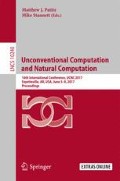Abstract
We study matrix insertion grammars (MIS) towards representation of recursively enumerable languages with small size. We show that pure MIS of size (3; 1, 2, 2) (i.e., having ternary matrices inserting one symbol in two symbol context) can characterize all recursively enumerable languages. This is achieved by either applying an inverse morphism and a weak coding, or a left (right) quotient with a regular language or an intersection with a regular language followed by a weak coding. The obtained results complete known results on insertion-deletion systems from DNA computing area.
Access this chapter
Tax calculation will be finalised at checkout
Purchases are for personal use only
References
Benne, R. (ed.): RNA Editing: The Alteration of Protein Coding Sequences of RNA. Series in Molecular Biology. Ellis Horwood, Chichester (1993)
Biegler, F., Burrell, M.J., Daley, M.: Regulated RNA rewriting: modelling RNA editing with guided insertion. Theoret. Comput. Sci. 387(2), 103–112 (2007)
Fernau, H., Kuppusamy, L., Raman, I.: Descriptional complexity of graph-controlled insertion-deletion systems. In: Câmpeanu, C., Manea, F., Shallit, J. (eds.) DCFS 2016. LNCS, vol. 9777, pp. 111–125. Springer, Cham (2016). doi:10.1007/978-3-319-41114-9_9
Fernau, H., Kuppusamy, L., Raman, I.: Generative power of matrix insertion-deletion systems with context-free insertion or deletion. In: Amos, M., Condon, A. (eds.) UCNC 2016. LNCS, vol. 9726, pp. 35–48. Springer, Cham (2016). doi:10.1007/978-3-319-41312-9_4
Freund, R., Kogler, M., Rogozhin, Y., Verlan, S.: Graph-controlled insertion-deletion systems. In: McQuillan, I., Pighizzini, G. (eds.) Proceedings Twelfth Annual Workshop on Descriptional Complexity of Formal Systems, DCFS. EPTCS, vol. 31, pp. 88–98 (2010)
Fujioka, K.: Morphic characterizations of languages in Chomsky hierarchy with insertion and locality. Inf. Comput. 209(3), 397–408 (2011)
Fujioka, K.: Morphic characterizations with insertion systems controlled by a context of length one. Theoret. Comput. Sci. 469, 69–76 (2013)
Galiukschov, B.S.: Semicontextual grammars (in Russian). In: Matematika Logica i Matematika Linguistika, pp. 38–50. Kalinin University (1981)
Geffert, V.: Normal forms for phrase-structure grammars. RAIRO Informatique théorique et Applications/Theor. Inform. Appl. 25, 473–498 (1991)
Haussler, D.: Insertion languages. Inf. Sci. 31(1), 77–89 (1983)
Ivanov, S., Verlan, S.: Random context and semi-conditional insertion-deletion systems. Fundamenta Informaticae 138, 127–144 (2015)
Jančar, P., Mráz, F., Plátek, M., Vogel, J.: Restarting automata. In: Reichel, H. (ed.) FCT 1995. LNCS, vol. 965, pp. 283–292. Springer, Heidelberg (1995). doi:10.1007/3-540-60249-6_60
Kari, L., Păun, G., Thierrin, G., Yu, S.: At the crossroads of DNA computing, formal languages: characterizing recursively enumerable languages using insertion-deletion systems. In: Rubin, H., Wood, D.H. (eds.) DNA Based Computers III. DIMACS Series in Discrete Mathematics and Theretical Computer Science, vol. 48, pp. 329–338 (1999)
Kari, L., Sosík, P.: On the weight of universal insertion grammars. Theoret. Comput. Sci. 396(1–3), 264–270 (2008)
Kari, L., Thierrin, G.: Contextual insertions/deletions and computability. Inf. Comput. 131(1), 47–61 (1996)
Krassovitskiy, A.: On the power of insertion P systems of small size. In: Martínez del Amor, M.A., Orejuela-Pinedo, E.F., Păun, G., Pérez-Hurtado, I., Riscos-Núñez, A. (eds.) Seventh Brainstorming Week on Membrane Computing, vol. II, pp. 29–43. Fénix Editora, Sevilla (2009)
Kuppusamy, L., Mahendran, A.: Modelling DNA and RNA secondary structures using matrix insertion-deletion systems. Int. J. Appl. Math. Comput. Sci. 26(1), 245–258 (2016)
Marcus, M., Păun, G.: Regulated Galiukschov semicontextual grammars. Kybernetika 26(4), 316–326 (1990)
Margenstern, M., Păun, G., Rogozhin, Y., Verlan, S.: Context-free insertion-deletion systems. Theoret. Comput. Sci. 330(2), 339–348 (2005)
Matveevici, A., Rogozhin, Y., Verlan, S.: Insertion-deletion systems with one-sided contexts. In: Durand-Lose, J., Margenstern, M. (eds.) MCU 2007. LNCS, vol. 4664, pp. 205–217. Springer, Heidelberg (2007). doi:10.1007/978-3-540-74593-8_18
Motwani, R., Panigrahy, R., Saraswat, V., Ventkatasubramanian, S.: On the decidability of accessibility problems (extended abstract). In: Proceedings of the Thirty-Second Annual ACM Symposium on Theory of Computing, STOC, pp. 306–315. ACM (2000)
Mutyam, M., Krithivasan, K., Reddy, A.S.: On characterizing recursively enumerable languages by insertion grammars. Fundamenta Informaticae 64(1–4), 317–324 (2005)
Onodera, K.: A note on homomorphic representation of recursively enumerable languages with insertion grammars. Trans. Inf. Process. Soc. Japan 44(5), 1424–1427 (2003)
Petre, I., Verlan, S.: Matrix insertion-deletion systems. Theoret. Comput. Sci. 456, 80–88 (2012)
Păun, G., Pérez-Jiménez, M.J., Yokomori, T.: Representations and characterizations of languages in Chomsky hierarchy by means of insertion-deletion systems. Int. J. Found. Comput. Sci. 19(4), 859–871 (2008)
Păun, G., Rozenberg, G., Salomaa, A.: DNA Computing: New Computing Paradigms. Springer, New York (1998)
Takahara, A., Yokomori, T.: On the computational power of insertion-deletion systems. Nat. Comput. 2(4), 321–336 (2003)
Verlan, S.: On minimal context-free insertion-deletion systems. J. Autom. Lang. Comb. 12(1–2), 317–328 (2007)
Author information
Authors and Affiliations
Corresponding author
Editor information
Editors and Affiliations
Rights and permissions
Copyright information
© 2017 Springer International Publishing AG
About this paper
Cite this paper
Fernau, H., Kuppusamy, L., Verlan, S. (2017). Universal Matrix Insertion Grammars with Small Size. In: Patitz, M., Stannett, M. (eds) Unconventional Computation and Natural Computation. UCNC 2017. Lecture Notes in Computer Science(), vol 10240. Springer, Cham. https://doi.org/10.1007/978-3-319-58187-3_14
Download citation
DOI: https://doi.org/10.1007/978-3-319-58187-3_14
Published:
Publisher Name: Springer, Cham
Print ISBN: 978-3-319-58186-6
Online ISBN: 978-3-319-58187-3
eBook Packages: Computer ScienceComputer Science (R0)

